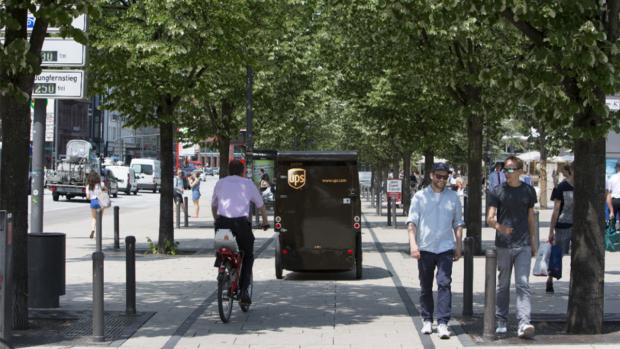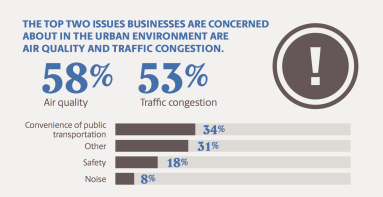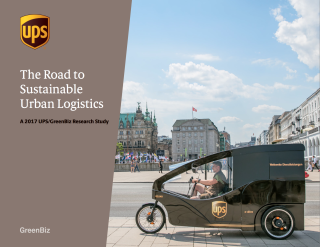Breakthrough Approaches for Sustainable Cities
The long-term health of cities matters – we must work together for a lasting future for our urban centers.
Mark Wallace | UPS
More and more of the world’s population is moving to cities.
According to the UN, by 2050 nearly two-thirds of the global population will live in cities, and urban populations will increase by 2 billion people.
While this mass migration will bring new, exciting opportunities for city residents, it also brings daunting challenges to urban environments and the businesses operating there.
The increase in traffic congestion, emissions and the demands on energy sources have not stemmed the tide of people moving to cities, and they have created rising concern among environmentalists, city officials and business leaders.
The question we are grappling with is simply stated but not easily solved: As the social and environmental effects of this urban migration unfold, how do we ensure a healthy and sustainable setting for city dwellers – and for the businesses supporting these local economies?
Solutions start with innovation and collaboration
When it comes to the challenges associated with this new urban environment, there’s no silver bullet. But there are logical ways to develop solutions that will require innovative and flexible thinking from a range of stakeholders.
A number of progressive thinkers already are creating viable, scalable solutions for crowded metropolises. From public sector investments that reduce our reliance on personal vehicles to concepts that would replace the traditional automobile in busy neighborhoods, municipalities are building cities that are healthier and more sustainable.
Businesses are stepping up as well. With the development of hybrid and electric cars and greater research investments from the automotive industry, the future of sustainable urban mobility is in sight.
However, personal mobility is just one piece of the puzzle. If we really want to reduce congestion, we must bring the same kind of innovation and partnership to the movement of goods to and from cities.
As a global logistics provider, UPS is involved in a growing number of sustainable solutions. Our approach has always been a collaborative one, focused on forging partnerships to create and implement practical, sustainable logistics practices.
For example, in London we’re part of a public-private consortium that is testing the use of electric- and foot-powered bikes for urban deliveries. And in Hamburg, Germany, we’re using zero-emissions eBikes to pick up and deliver packages on the city’s narrow streets.
By using the same mix of technology and creative thinking in places such as Dublin, Paris and Leuven, we are working on ways to engage cities to ease congestion while ensuring the timely movement of goods that global commerce demands.
Testing and deploying alternative fuels and technologies is only part of the equation. We’re also seeing results from consolidating “final-mile” deliveries, the last segment in the logistics network, where goods are delivered to the consumer or business that ordered them.
We’re reaching further in our collaboration efforts to give city dwellers more control over when, where and how they receive their packages. These technology-driven solutions help avoid missed deliveries and eliminate the environmental impact of wasted trips.
Sustainability requires ongoing commitment
While progress is being made, it’s clear no one entity can meet the future needs of sustainable cities.
In a research study by UPS in collaboration with GreenBiz, we clearly saw the importance of collaboration to create sustainable change. As suggested by Ani Dasgupta, Global Director of the World Resources Institute’s Ross Center for Sustainable Cities, “If you want to continue a path of reform or change, you really need a coalition that can sustain or live beyond a single mayor. That is why you need to bring all of the interested parties together so the momentum of change is sustained for a longer time.”
The goals are clear: reduce personal vehicle use, improve quality of life and reduce carbon footprints. But each city is different, and an intimate understanding of the unique needs of each urban market is essential.To succeed, businesses need to work together with city leaders and their constituents to create custom solutions.
City planners, community groups, academics and businesses will need insight-driven models informed by robust data to develop the right solutions. By applying these insights to different approaches, we can identify and share best practices – helping to solve common urban challenges around the world.
Redefining progress, ensuring the future
The long-term health of cities matters. And it’s critical that we work together to ensure bright futures for our urban centers.
As we look ahead, I encourage cities, businesses and academia to continue to redefine how we achieve progress and work together on an array of new solutions.
This will require innovation, partnership and experimentation to ensure cities remain a desirable place to live and work for generations to come.
This article first appeared on the Justmeans blog and was republished with permission.




